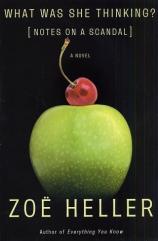What Was She Thinking?: Notes on a Scandal
Review
What Was She Thinking?: Notes on a Scandal
In England, where it was shortlisted for the Booker Prize, Zoë Heller's second novel was titled simply NOTES ON A SCANDAL. But her American publisher, Henry Holt, restyled it WHAT WAS SHE THINKING? and relegated the drab NOTES to a subtitle.
Such is a rare case when business beats artistry: Heller's original title is humdrum and unevocative, while WHAT WAS SHE THINKING? is both colloquial and sensational, a tabloid headline that aptly captures the novel's tabloid affair.
The American title is all the more fitting because WHAT WAS SHE THINKING? is an extremely American novel, despite being set in England. Heller, who wrote about Hollywood and celebrity culture in her lackluster debut, EVERYTHING YOU KNOW, finds inspiration for this novel in the 1997 case of Mary Kay Latourneau, a Washington State teacher who had an affair and two children with a teenage student.
At the center of the scandal is the obviously named Bathsheba Hart, a naïve pottery teacher at St. George's Academy in London. Mobbed by undisciplined teenagers and cowed by teachers' lounge politics, Sheba befriends a fifteen-year-old remedial student named Steven Connolly. At first she is drawn to him because he is one of the few students who does not terrorize her. He has a talent for drawing, and in several after-school sessions she encourages his artistic tendencies, exposing him to the work of Degas and Manet. Soon, however, their relationship leads to trysts behind the pottery kiln and secret rendezvous in Hampstead Heath.
Their affair and the ensuing media frenzy it ignites are recounted by Barbara Covett, a lonely history teacher who craves Sheba's friendship. Barbara is a catty narrator, disdainful of her students and suspicious of her colleagues, and her observations and petty critiques of her surroundings are feisty, witty and endlessly entertaining.
If Heller finds inspiration in U.S. tabloids, she is similarly fascinated with Vladimir Nabokov, who himself was interested in America's garish pop culture. She intends Sheba's affair with the student to suggest a gender-switched LOLITA, and the relationship between the two teachers mirrors that of the protagonists in PALE FIRE: Barbara is Charles Kinbote to Sheba's John Shade. She is ostensibly recording the scandal and defending her friend for posterity, but in the process she takes center stage. WHAT WAS SHE THINKING? is less about Sheba's untoward feelings toward a student than about Barbara's increasing dependence on Sheba as a balm against her own loneliness and "drip, drip of long-haul, no-end-in-sight solitude."
Heller plumbs remarkable depths in Barbara's isolation from the world and in her murky relationship with her coworker. Towards the end of the novel, Barbara confesses that her response to her friend's affair and her actions to expose it have been reprehensible: "If I seem to take particular care in describing how I came to act as I did, it is not because I hope to exculpate myself, but rather because I wish to be as rigorously and unsparingly truthful as possible." Yet, Barbara is at her most sympathetic when she is at her lowest point. Her actions may be driven by half-defined desires for Sheba, but Heller delves deep into her character and makes her fully human.
Of course, WHAT WAS SHE THINKING? cannot live up to its source material: it lacks the profound inventiveness and meaning of Nabokov's novels and the real-life scandal of Latourneau's story. But the novel does have its comparatively modest triumphs. By letting her narrator outshine the salacious scandal she chronicles, Heller creates in Barbara a memorable character with a unique perspective and a resounding voice.
Reviewed by Stephen M. Deusner on January 24, 2011
What Was She Thinking?: Notes on a Scandal
- Publication Date: August 1, 2003
- Genres: Fiction
- Hardcover: 272 pages
- Publisher: Henry Holt and Co.
- ISBN-10: 0805073337
- ISBN-13: 9780805073331










